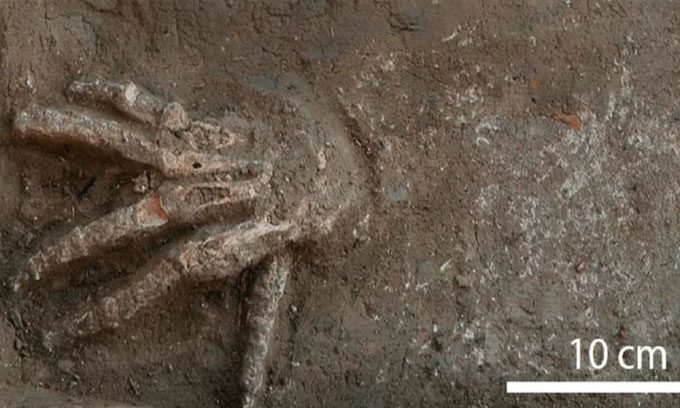At least 12 hands were buried in 3 pits located right at the entrance of the Hyksos palace, easily visible to anyone visiting the king.
A research team led by scientist Julia Gresky from the German Archaeological Institute analyzed the hands buried under 3 pits in the Hyksos palace at Avaris in northeastern Egypt, as reported by Phys on April 5. This represents the first physical evidence of an ancient custom mentioned in literary texts and hieroglyphs, shedding light on the darker aspects of the history of ancient Egyptian civilization. The new study has been published in the journal Scientific Reports.

A hand buried during the Hyksos period. (Photo: Julia Gresky).
Constructed around 1640 – 1530 BC, the Hyksos palace was the capital of the Hyksos Dynasty during Egypt’s Second Intermediate Period. The Hyksos originated from Western Asia. They established a dynasty in Egypt and are believed to have introduced the custom of severing the right hand of enemies.
The hands were discovered in 3 separate pits in an area that was once the entrance to the palace, right in front of the throne room. This location was likely chosen to be prominently visible and to create an impressive setting for anyone meeting the king.
Since all the hands were not intact and were buried together, the research team had to use a common method found in mass graves to determine the minimum and maximum number of hands. As a result, the estimated number of hands ranges from 12 to 18.
The team also determined that the minimum age of the hand owners was between 14 and 21, as the bones had fully developed after adolescence. There were no signs of age-related degeneration, so the maximum age was assessed to be under 60. Anatomical traces indicated that 11 of the hands belonged to males. The twelfth hand likely belonged to a female, but this is not certain.
The experts are unclear whether these hands were taken from the deceased or the living. In either case, the hands remained soft and flexible when placed in the pit. Analysis suggests they were most likely buried within 24 to 48 hours after collection. Another notable point is that there were no traces of forearms, indicating careful separation of the hands.
The victims were likely to have had their hands severed during or just before a ceremony at the palace, according to the research team. For the ancient Celts, fallen warriors were often decapitated during and after battle and then displayed on stakes as trophies. In this new study, scientists believe that the practice of severing the right hand of enemies – referred to as “taking trophies” – was introduced to Egypt by the Hyksos.





















































